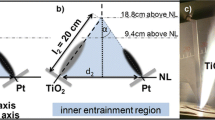Abstract
This paper deals with a method for production of nanopowders of high-melting metal oxides by burning the starting metal powders in a laminar disperse flame. The method is called gas-dispersed synthesis. The combustion-zone structure for a laminar diffusion dispersed flame and for a laminar flame of premixed fuel and oxidizer was studied experimentally. Information was obtained on the temperature of combustion gases and its spatial distribution, the temperatures of the burning particles and of the condensed combustion products, and the combustion regimes of metal particles. The dependence of the properties of the resulting oxides on the flame and combustion-zone parameters and the mechanism of particle combustion is studied. Based on the results, an attempt is undertaken to reproduce the mechanisms of formation and growth of the condensed phase under conditions of laminar diffusion flames. The mass-averaged particle size of the oxide powders is estimated.
Similar content being viewed by others
References
A. G. Merzhanov, “Self-propagating high-temperature synthesis,” in:Physical Chemistry. Modern problems [in Russian], Khimiya, Moscow (1983).
Inventors Certificate No. 1175871, SSSR, “Method of ZrO2 production.”
Inventors Certificate No. 255225, SSSR, “Method of production of red oxide of Fe.”
Inventors Certificate No. 1330923, SSSR, “Method of Al2O3 production.”
Patent No. 56-9448, Japan, “Method of Al2O3 production for ceramic manufacture.”
Economic Patent No. 232907, GDR, “Method of production of powdered zirconium oxide.”
Patent No. 2578241, France. “Sensitized zirconium dioxide, method of its production and use in ceramic compositions.”
Patent No. 1520756, Great Britain, “Method of γ = Fe2O3 production.”
Patent No. PS 2455034, FRG, “Method of production of titanium dioxide.”
A. S. Brown, “Ceramics is taught to bend but not to break,”Aerocosm. Tekh. No. 3, 132 (1991).
N. D. Ageev, Ya. I. Vovchuk, S. V. Goroshin, et al., “Method of production of ultradispersed metal oxide powders,” Favorable decision on patent No. 4936888/26(041343), May 16, 1991.
N. D. Ageev, S. N. Buinovskii, Ya. I. Vovchuk, S. V., et al. “Laminar diffusion two-phase flame,” in:First All-Union Symposium on Macrokinetics and Chemical Gasdynamics, Alma-Ata (1984), Vol. 2, Part 1, p. 353.
V. G. Shevchuk, L. V. Boichuk, S. V. Goroshin, and Yu. N. Kostyshin, “Comparative research of flame propagation in boron and Al, Mg, Zr, Fe Dust Clouds,” in: 2nd Int. Symposium on Special Topics in Chemical Propulsion, Lampoldshausen, Germany (1991).
N. D. Ageev, Ya. I. Vovchuk, S. V. Goroshin, A. N., et al. “Stationary combustion of solid fuel gas-suspensions. Laminar diffusion two-phase flame,”Fiz. Goreniya Vzryva,26, No. 6, 54–62 (1990).
V. M. Gremyachkin, A. G. Istratov, and O. I. Leipunskii, “Model for combustion of metal droplets with allowance for the formation of a condensed oxide,” in:Combustion and Explosion [in Russian], Nauka, Moscow (1977), pp. 329–335.
A. Ya. Lukin and A. M. Stepanov, “Theoretical investigation of the formation of condensed products in metal particle combustion,”Fiz. Goreniya Vzryva,19, No. 4, 45–49 (1983).
A. V. Florko, A. N. Zolotko, N. V. Kaminskaya, and V. G. Shevchuk, “Spectral studies of magnesium particle combustion,”Fiz. Goreniya Vzryva,18, No. 1, 17–22 (1982).
A. V. Florko, S. V. Kozitskii, A. N. Zolotko, and V. V. Golovko, “On the mechanism of transfer of condensed combustion products to a burning magnesium particle surface,”Fiz. Goreniya Vzryva,19, No. 6, 24–29 (1983).
N. I. Belinskii, S. V. Kozitskii, and A. V. Florko, “High-speed spectral apparatus for investigation of radiative characteristics of dispersed combustion products,” in:Physics of Air-Dispersed Systems,28 (1985), pp. 38–42.
A. V. Florko, V. V. Golovko, and V. G. Skogarev, “Coefficients of scattering and absorption efficiency of MgO particles at combustion temperatures,”Fiz. Goreniya Vzryva,25, No. 3, 28–32 (1989).
A. V. Florko, V. V. Golovko, N. A. Okhrimenko, and V. G. Shevchuk, “Structure of combustion zone of magnesium particles. 1. Optospectral studies,”Fiz. Goreniya Vzryva,27, No. 1, 37–42 (1991).
G. Markstein, “Analysis of a diluted diffusion flame sustained by a heterogeneous reaction,” in:Heterogeneous Combustion [Russian translation], Nauka, Moscow (1967), p. 182–206.
A. N. Zolotko, “Ignition and combustion of boron dust systems,”Second Int. Symp. on Special Topics in Chemical Propulsion, Lampoldshausen, Germany (1991).
A. N. Zolotko, S. A. Kiro, Ya. I. Vovchuk, and I. A. Bobreshov, “The mechanisms of ignition and combustion of ash-rich coal,” Abstracts of the 23th Int. Symp. on Combustion, Orleans, France (1990), p. 278.
L. A. Klyachko, “Combustion of a stationary particle of a low-boiling metal,”Fiz. Goreniya Vzryva,5, No. 3, 404–413 (1969).
O. E. Kashireninov, “Mechanism and model of magnesium vapor oxidation in oxygen,” Abstracts of the 23th Symposium on Combustion, Orleans, France (1990).
P. KofstadHigh-Temperature Oxidation of Metals [Russian translation], Mir, Moscow (1969).
T. Brzustowski and I. Glassman “Spectroscopic study of metal combustion,” in:Heterogeneous Combustion [Russian translation], Nauka, Moscow (1967), pp. 57–90.
O. E. Kashireninov, A. D. Chervonnyi, and V. A. Piven', “On the determination and thermodynamic characteristics of AlO2,” Preprint, Joint Institute of Chemical Physics, USSR Academy of Sciences, Chernogolovka (1979).
A. V. Florko and V. V. Golovko, “Nucleation and growth of a condensed phase in magnesium particle combustion,” in:Rheophysics and Thermal Physics of Nonequilibrium Systems: Proc. Int. School-Seminar, Minsk (1991), Part 2, pp. 103–106.
A. A. Arshinov and A. K. Musin, “Equilibrium ionization in dispersed systems,”Radiotekh. Électron., No. 5, 890–899 (1962).
Author information
Authors and Affiliations
Additional information
Translated from Fizika Goreniya i Vzryva, Vol. 32, No. 3, pp. 24–33, May–June, 1996.
Rights and permissions
About this article
Cite this article
Zolotko, A.N., Vovchuk, Y.I., Poletayev, N.I. et al. Synthesis of nanooxides in two-phase laminar flames. Combust Explos Shock Waves 32, 262–269 (1996). https://doi.org/10.1007/BF01998454
Received:
Revised:
Issue Date:
DOI: https://doi.org/10.1007/BF01998454




